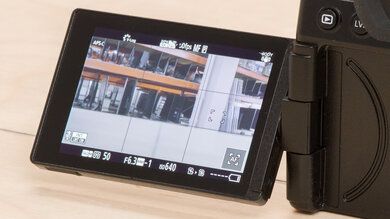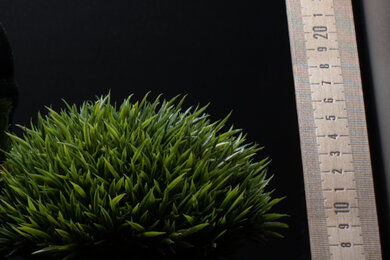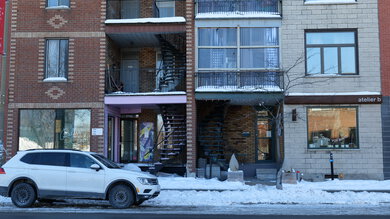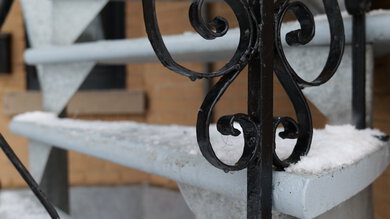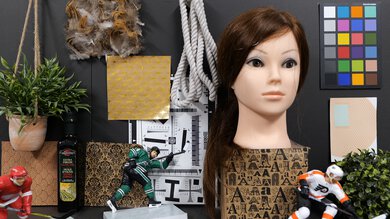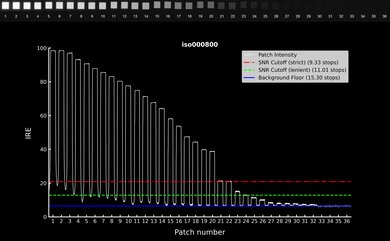The Panasonic LUMIX S5 is a full-frame mirrorless camera. One of Panasonic's first consumer full-frame cameras, it has a lot to offer for hybrid shooters, with some excellent video features for its generation. Features like internal 10-bit 4:2:2 capture, support for a wide range of formats/codecs, and a great in-body image stabilization (IBIS) system stand out. However, its outdated contrast-based autofocus system and slow max burst rate leave something to be desired for photographers.
Our Verdict
The Panasonic S5 is great for travel photography if you don't mind a bulkier kit. Though it's on the heavier and bulkier side for a mirrorless camera, its full-frame sensor captures fantastic image quality. It's also well-built, for the most part, with weather-sealing and excellent ergonomics. In-body image stabilization can also help you capture images at slower shutter speeds. However, it doesn't have the most reliable autofocus system, as it can have some issues keeping up with faster subjects or subjects in busier settings.
- Fantastic image quality.
- Great build quality.
- Very comfortable to shoot with.
- Not very portable for travel.
- Autofocus tracking isn't the most reliable.
The Panasonic S5 is excellent for landscape photography. Its full-frame sensor is well-suited to landscapes, with incredible dynamic range to capture a wide array of detail in high-contrast scenes, and it performs well in low light. The camera is also weather-sealed to give you some added peace of mind when shooting in adverse weather conditions. It also has a pretty good battery life. That said, it's fairly heavy and bulky for a mirrorless camera.
- Fantastic image quality.
- Great build quality.
- Very comfortable to shoot with.
- Relatively bulky design.
- Autofocus tracking isn't the most reliable.
The Panasonic S5 is good for sports and wildlife photography. Its high-resolution full-frame sensor captures excellent image quality, and it has fantastic ergonomics. That said, its max burst rate isn't particularly high, making it hard to capture distinct images of fast-moving subjects for those who prefer to rely on continuous shooting modes. Its autofocus system can also be a bit sluggish with very fast-moving subjects.
- Fantastic image quality.
- Great build quality.
- Very comfortable to shoot with.
- Autofocus tracking isn't the most reliable.
- Slow maximum shooting speed.
The Panasonic S5 is a good video camera, but it isn't ideal for on-the-go vlogging because of its size and weight. It's on the heavier side for a mirrorless camera. Its contrast-based autofocus system does a pretty good job of tracking faces in video, but it can also be a bit unreliable and sometimes create a distracting pulsing effect. On the upside, it does have a fully articulated screen that makes it easy to monitor yourself, and IBIS helps smooth out camera shake.
- Excellent video quality.
- In-body image stabilization.
- Bright, sharp, fully-articulated screen.
- Autofocus tracking isn't the most reliable.
- Not very portable for vlogging.
The Panasonic LUMIX S5 is fantastic for studio video. Videos are sharply rendered and low in noise, and the camera has a very wide dynamic range to preserve more detail in trickier lighting conditions. It records 4k video at up to 60 fps in a fairly wide range of recording formats and codecs, although shooting at 60 fps in 4k is only available with an APS-C crop. Still, it can capture 10-bit 4:2:2 video internally, with 12-bit RAW video output via HDMI. It also features a wide variety of inputs and outputs for various videography accessories, like external recorders, headphones, or microphones, though it doesn't have a full-sized HDMI port. If you prefer using autofocus, it also uses a slower contrast-based AF system that doesn't have the most reliable tracking feature.
- Excellent video quality.
- Wide selection of inputs and outputs.
- 10-bit 4:2:2 internal recording.
- Autofocus tracking isn't the most reliable.
The Panasonic S5 isn't designed for action video. It's too big to be mounted on a chest or helmet rig and isn't waterproof. Its high frame rate options are also somewhat limited in 4k, though it does have a slow-motion mode in 1080p.
- Great build quality.
- In-body image stabilization.
- Not designed for action video rigs.
- Relatively limited high-speed frame rates.
- Autofocus tracking isn't the most reliable.
The Panasonic LUMIX S5 has excellent RAW image quality. It has incredible dynamic range, so it preserves a very wide range of shadow and highlight detail. Images also look sharp, thanks to its high-res sensor. Its noise handling in low light is also very good overall.
- Fantastic dynamic range.
- Sharp resolution, with good noise handling.
Performance Usages
Changelog
-
Updated Dec 12, 2024:
We wrote text for the new tests added in Test Bench 0.13 and updated the Verdict section accordingly.
- Updated Dec 12, 2024: We've converted this review to Test Bench 0.13. We've added new tests for Video Dynamic Range and Luminosity Patch Detection. You can learn more about these updates in the changelog.
- Updated Jan 29, 2024: Added text to the 'Raw Photo Performance' verdict box.
- Updated Jan 29, 2024: Converted to Test Bench 0.12.1.
Check Price
Differences Between Sizes And Variants
The Panasonic LUMIX DC-S5 only comes in one color variant: 'Black'; you can see our unit's label here. We purchased it with the Panasonic LUMIX S 20-60mm F3.5-5.6 lens, but other L-mount lenses can be fitted to the camera. You can also buy the body on its own without a lens.
Let us know if you come across another variant so we can update our review.
Popular Camera Comparisons
The Panasonic LUMIX S5 is an excellent hybrid camera for its price and class. It's somewhat ahead of its time for video features, rocking 10-bit internal recording and 4k at 60 fps before these features started to become more commonplace among consumer cameras. However, its autofocus system is notably less effective and reliable compared to peers like the Canon EOS R6 or the Sony α7 III.
For more options, check out the best 4k cameras, the best full-frame mirrorless cameras, or the best cameras we've tested in general.
The Panasonic LUMIX S5 II offers some improvements over the Panasonic LUMIX S5, including a new processing engine and a slightly redesigned body, with heat vents to reduce overheating and enable longer video recording. It also has a new phase-detection autofocus system, and it definitely helps in video, reducing the distracting background pulse that happened with the older contrast-based system. However, it still struggles to keep up when shooting photos continuously. The S5 II expands on some of the S5's video capabilities, with 6k open gate recording and no recording time limits, but it also lacks RAW video output out of the box, unlike the original S5.
The Panasonic LUMIX DC-S5 and the Sony α7 IV are both great full-frame mirrorless cameras that perform well in photo and video. They can record 4k 10-bit 4:2:2 video internally at up to 60 fps. Both have fully articulated screens and sturdy, weather-sealed bodies and are similar in size and weight. That said, while the Panasonic has better overall stabilization performance, the Sony has a significantly better autofocus system, takes CFexpress Type A cards as well as UHS-II SD cards, and can shoot at 120 fps in 1080p.
The Panasonic LUMIX DC-S5 and the Panasonic LUMIX GH5s use different sensor sizes, and they're aimed at different kinds of shooters. The S5 is a full-frame hybrid camera that's a better fit for those primarily interested in photography. Its larger sensor is more suited to low light and provides better bokeh. It also has IBIS for more stable handheld shooting and an improved autofocus system. However, the GH5s has a bit more to offer for filmmakers, including anamorphic 4k and Cinema 4k up to 60p and All-Intra video compression.
Test Results

The Panasonic LUMIX S5 isn't particularly portable but isn't bad for a full-frame camera. That said, it's on the heavier side for a mirrorless model. It'll feel well-balanced with full-frame lenses, but it can also cause fatigue during long days on the go.
The Panasonic S5 is a well-built camera, for the most part. It's made of metal and plastic, with buttons and dials that offer pretty good physical feedback. The screen mechanism and dials feel sturdy, too. That said, over time, we've noticed some wear and tear. For example, the coating on the camera's feet has rubbed off, exposing the metal underneath and leaving faint marks on wooden surfaces. Additionally, SD card slot 1, the only UHS-II compatible slot, has stopped working. When a card is inserted, the camera gives an error message, saying, "Reinsert the card" until the card is removed. The slot doesn't appear to have sustained any physical damage, and the error persists even after restarting and updating the camera.
The Panasonic S5 has excellent ergonomics. Its handgrip is large enough for most hand sizes and has a textured rubber surface that provides a secure hold. Changing aperture, shutter speed, and ISO is easy with either eye pressed up against the viewfinder thanks to the dedicated controls for exposure adjustment functions, and all essential functions are well-placed and within reach of your fingers. The rubber eyecup around the viewfinder also feels comfortable to shoot with. That said, the camera's more squared-off body isn't quite as comfortable to hold as cameras with a more rounded body, like the Canon EOS R6.
The electronic viewfinder (EVF) is large and comfortable to shoot with. It doesn't have the highest resolution, but at 2.36 million dots, you'll still have a crisp view of your subjects.
The touchscreen is fully articulated and gets very bright, so glare won't be an issue on sunny days. It also has a very high resolution, giving you a crisp image on the display. You can use the touchscreen to select focus points, activate the shutter, and navigate the menu.
The camera's user interface is amazing. Settings are clearly organized and labeled, making it easy to find what you're looking for. You can also create a custom menu for all of your most-used settings, and there are plenty of customization options, including for the quick menu.
The Panasonic S5 uses a 24.2-megapixel full-frame sensor, using Panasonic's Venus Engine processor. It's a dual gain sensor, meaning it has two native 'base' ISO settings, at ISO 100 and ISO 640. However, unlike the Panasonic LUMIX S5 II, you can't manually limit the camera to one or the other ISO range.
The Panasonic LUMIX S5 has an excellent overall battery life. It's CIPA-rated for 440 photos on a full charge, which is great. CIPA ratings tend to be more conservative estimates, so your real-world usage will vary depending on your shooting habits.
Video battery life is fantastic. We recorded over two hours of continuous video in 4k. You can extend the camera's battery life by using an external power supply via USB-C, though the battery won't charge while using the camera with external power.
The camera doesn't have the fastest burst rate. While you can still capture sequential bursts of fast action, timing will be more critical. It also falls significantly short of competitors like the Canon EOS R6 or the Nikon Z 6II. If you're shooting in RAW format, the buffer fills up quite quickly. Thankfully, it doesn't take too long to empty, but it can still slow you down at a crucial moment. That said, if you're shooting JPEGs, the buffer is virtually limitless.
Like most LUMIX cameras before it, the Panasonic S5 uses a contrast-detection autofocus system. While the camera has a human/animal subject detection mode—which you can set to track faces, bodies, or eyes—it's separate from the dedicated AF-C 'Tracking' mode. That means that when you need to track a subject continuously, you're at the mercy of the camera's auto-subject detection. It does an okay job of keeping moving subjects in focus, but it can still slip out of focus with faster or more erratic movement.
When using a single center focus point, you can get excellent results. It keeps up well with any subject behind the focus point, which is great if you have someone moving in a more predictable pattern. We tested AF with the LUMIX S 20-60mm f/3.5-5.6 lens.
The S5 has a five-axis in-body image stabilization system, and it does a great job. We managed to get clear handheld images at very slow shutter speeds, using the LUMIX S 20-60mm f/3.5-5.6 lens, which doesn't have optical stabilization. It's worth noting, however, that stabilization performance can vary depending not just on your lens but also factors like focal length and how steady your hands are.
The camera has superb usable dynamic range. It can capture a very wide range of highlight and shadow detail in high-contrast scenes like landscape photos or images with harsh shadows and tricky lighting.
The camera's high-resolution sensor captures an amazing level of fine detail. Even when punching in, there's plenty of sharpness and resolution.
The Panasonic S5 has very good RAW noise handling. It's well suited to low-light photography, so you won't have overwhelmingly noisy photos in situations where light is limited.
The Panasonic S5 has some pretty advanced video features, which have only gotten better with firmware updates. After firmware ver. 2.0, the camera supports DCI 4k (4096x2160), or 'C4K' in Panasonic's terminology, as well as regular UHD 4k. The update also adds support for 12-bit RAW video output in 5.9k or 4k via HDMI with a compatible Atomos or Blackmagic external recorder. If you prefer a more hands-off approach, the camera also comes with plenty of pre-set picture profiles, or 'Photo Styles', as well as supporting HLG and Log recording in V-Log format. You can also create up to 10 custom Photo Styles. For Log and HLG, there's a handy 'View Assist' feature that simulates what your footage will look like after processing. If you're looking for even more advanced video features, including open gate 6k recording, check out the Panasonic LUMIX S5 II.
The camera records 4k video at up to 60 fps, although 60 fps is only available with an APS-C crop, similar to the Sony α7 IV. If you'd prefer a camera that can record 4k 60p video without a crop, consider the Panasonic LUMIX GH5s.
The camera's internal 4k recording capability is excellent. It can capture 10-bit 4:2:2 video internally, giving you more leeway in post. Heat management is great, as the camera didn't overheat throughout the entirety of our battery test. That said, there's a 30-minute recording time limit when recording in 10-bit 4k at any frame rate in both MP4 and MOV, as well as 8-bit 4k at 60 fps in MOV format. Unlimited recording is available in 8-bit 4k at 30 fps or 24 fps in either format.
The camera's autofocus performs very well in video mode, although it falls behind competitors like Sony and Canon. The camera supports face and eye detection but can't keep up with moving subjects seamlessly. Its contrast-based AF can also create pulsing artifacts in the background of your videos.
There's some pretty noticeable rolling shutter distortion in 4k whenever you pan the camera from side to side. This can be a problem if you shoot things like action video or anything with quick pans.
The camera can capture regular 1080p footage at up to 60 fps. It also has a Slow & Quick (S&Q) mode that lets you record slow-motion footage at up to 180 fps, with slow-motion playback. Playback speed options include 60 fps, 30 fps, or 24 fps, so you can adjust the level of slow-mo. This mode doesn't record any audio.
Internal recording is still amazing in 1080p. There's no recording time limit here, and the camera can capture 10-bit 4:2:2 video internally.
The camera's autofocus performs very well in video mode, although it falls behind competitors like Sony and Canon. The camera supports face and eye detection but can't keep up with moving subjects seamlessly. Its contrast-based AF can also create pulsing artifacts in the background of your videos.
Rolling shutter effect is less noticeable in 1080p, which is good for anything that requires panning camera movements. There's still some slanting of vertical lines with quick movement, but it's less severe.
The Panasonic LUMIX S5 has fantastic video dynamic range overall, with a very wide range of total stops above the background floor. However, when taking noise into account, you'll have around 11 stops of usable dynamic range at base ISO 640 in V-Log. That's more than enough to capture high-contrast scenes or preserve more detail in trickier lighting conditions. Because of the sensor's dual native ISO design, there's a bump in dynamic range back up to about 10 or 11 stops at ISO 4000, which gives you a bit more flexibility with exposure in low light.
Tested settings:
- Resolution: 4k
- Frame Rate: 30 fps
- Log Format: V-Log
The camera has the greatest range of detail above and below middle gray around its base ISO of 640 when shooting in V-Log. It's especially good at preserving shadow detail across its ISO range, giving you more latitude when shooting darker scenes.
Tested settings:
- Resolution: 4k
- Frame Rate: 30 fps
- Log Format: V-Log
The Panasonic S5 has two SD card slots, though only one is rated for faster UHS-II cards. Still, this is great if you want to keep a running backup or separate RAW and JPEG files to different cards. They're well-placed on the side of the camera, too, making it easy to switch out cards when using a tripod.
The camera has a USB-C port for charging, power delivery, and file transfer. Unlike the Panasonic LUMIX S5 II, the S5 uses a micro HDMI port, so you'll likely need an adapter to connect an external recorder or display. Otherwise, it has all the ports you need to connect video peripherals, like an external mic or headphones.







